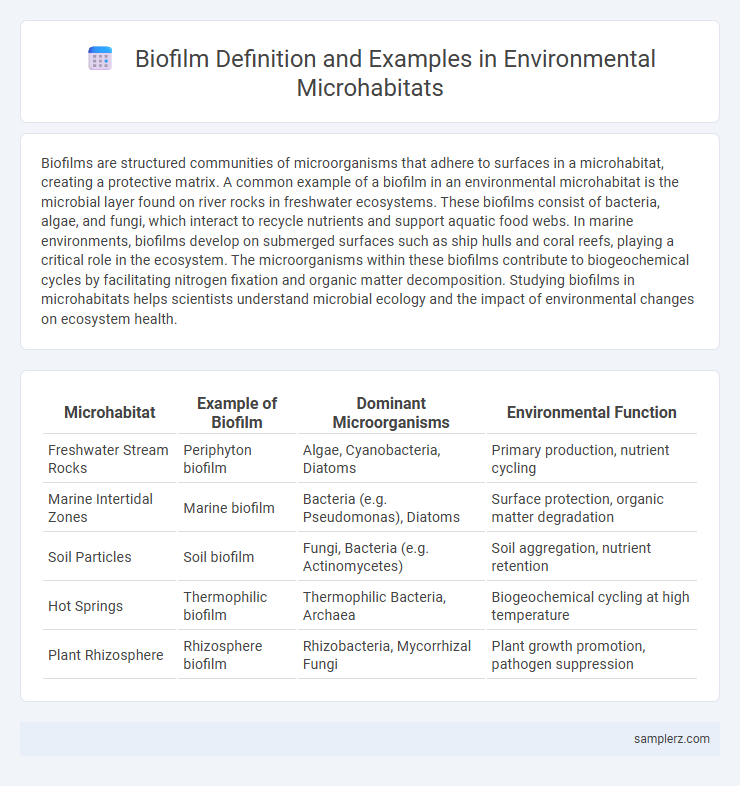Biofilms are structured communities of microorganisms that adhere to surfaces in a microhabitat, creating a protective matrix. A common example of a biofilm in an environmental microhabitat is the microbial layer found on river rocks in freshwater ecosystems. These biofilms consist of bacteria, algae, and fungi, which interact to recycle nutrients and support aquatic food webs. In marine environments, biofilms develop on submerged surfaces such as ship hulls and coral reefs, playing a critical role in the ecosystem. The microorganisms within these biofilms contribute to biogeochemical cycles by facilitating nitrogen fixation and organic matter decomposition. Studying biofilms in microhabitats helps scientists understand microbial ecology and the impact of environmental changes on ecosystem health.
Table of Comparison
| Microhabitat | Example of Biofilm | Dominant Microorganisms | Environmental Function |
|---|---|---|---|
| Freshwater Stream Rocks | Periphyton biofilm | Algae, Cyanobacteria, Diatoms | Primary production, nutrient cycling |
| Marine Intertidal Zones | Marine biofilm | Bacteria (e.g. Pseudomonas), Diatoms | Surface protection, organic matter degradation |
| Soil Particles | Soil biofilm | Fungi, Bacteria (e.g. Actinomycetes) | Soil aggregation, nutrient retention |
| Hot Springs | Thermophilic biofilm | Thermophilic Bacteria, Archaea | Biogeochemical cycling at high temperature |
| Plant Rhizosphere | Rhizosphere biofilm | Rhizobacteria, Mycorrhizal Fungi | Plant growth promotion, pathogen suppression |
Introduction to Biofilms in Environmental Microhabitats
Biofilms in environmental microhabitats form complex microbial communities attached to surfaces such as river rocks, soil particles, and plant roots, where they facilitate nutrient cycling and protection. These biofilms often consist of bacteria, fungi, and algae embedded in extracellular polymeric substances (EPS) that enhance resilience against environmental stresses. The microhabitat-specific biofilm structure influences water quality, soil fertility, and ecosystem stability by mediating biochemical processes and microbial interactions.
Biofilm Formation in Soil Ecosystems
Biofilm formation in soil ecosystems occurs when microbial communities attach to soil particles, creating protective matrices that enhance nutrient retention and microbial survival. These biofilms facilitate biochemical cycles by promoting organic matter decomposition and nutrient exchange among bacteria, fungi, and archaea. Soil biofilms also improve soil structure and moisture retention, supporting plant growth and ecosystem resilience.
Freshwater Microhabitats: Stream and Pond Biofilms
Stream and pond biofilms in freshwater microhabitats consist of complex communities of microorganisms, including bacteria, algae, and fungi, embedded in a self-produced extracellular matrix. These biofilms play a crucial role in nutrient cycling, organic matter decomposition, and providing habitat for aquatic invertebrates. In streams, biofilms adhere to rocks and submerged surfaces, while in ponds, they form on sediments and plant surfaces, influencing water quality and ecosystem stability.
Marine Biofilms: Coastal and Deep-Sea Examples
Marine biofilms form complex microbial communities on surfaces in both coastal and deep-sea environments, playing critical roles in nutrient cycling and habitat formation. Coastal biofilms often develop on rocks, algae, and man-made structures, facilitating larval settlement and protecting against corrosion. In deep-sea habitats, biofilms colonize hydrothermal vents and mineral deposits, supporting chemoautotrophic bacteria essential for primary production in these extreme ecosystems.
Biofilms in Plant Rhizosphere Microhabitats
Biofilms in plant rhizosphere microhabitats consist of diverse microbial communities that adhere to root surfaces, enhancing nutrient availability and plant health. These biofilms facilitate nitrogen fixation, phosphate solubilization, and protection against pathogens, contributing significantly to soil fertility and ecosystem stability. Microorganisms such as Rhizobium, Pseudomonas, and Bacillus species dominate these biofilms, optimizing root-microbe interactions within this critical microhabitat.
Biofilms on Rock Surfaces and Cave Walls
Biofilms forming on rock surfaces and cave walls create complex microhabitats that host diverse microbial communities essential for nutrient cycling and mineral weathering. These biofilms consist of bacteria, fungi, and algae embedded in a self-produced extracellular matrix, enabling them to adhere to harsh, nutrient-poor substrates while protecting against environmental stressors. Their metabolic activities contribute to biogeochemical processes, influence cave geomorphology, and support unique ecosystems in these oligotrophic environments.
Biofilms in Extreme Environments: Hot Springs and Polar Regions
Biofilms in extreme environments such as hot springs and polar regions consist of microbial communities adapted to survive harsh conditions like high temperatures, acidity, and freezing temperatures. Thermophilic bacteria and archaea form resilient biofilms in hot springs, where temperatures often exceed 70degC, enabling biochemical processes crucial for nutrient cycling. In polar regions, psychrophilic microorganisms create biofilms on ice and snow surfaces, protecting cells from freezing stress and facilitating metabolic activity despite subzero temperatures.
Role of Biofilms in Wastewater Treatment Microhabitats
Biofilms in wastewater treatment microhabitats facilitate the degradation of organic pollutants by providing a structured environment for diverse microbial communities. These biofilms enhance nutrient cycling and contaminant breakdown through synergistic microbial interactions, improving treatment efficiency. Their extracellular polymeric substances (EPS) protect microbes from toxic substances, sustaining microbial activity under variable environmental conditions.
Biofilms on Artificial Surfaces in Urban Environments
Biofilms on artificial surfaces in urban environments commonly develop on water pipes, building facades, and transportation infrastructure, where microbial communities form protective layers influencing material durability and water quality. These biofilms consist of bacteria, fungi, and algae embedded in an extracellular matrix that enhances resilience to environmental stressors and antimicrobial treatments. Their presence can lead to corrosion, clogging, and increased maintenance costs, highlighting the importance of monitoring biofilm development in urban microhabitats.
Ecological Significance and Impact of Microhabitat Biofilms
Biofilms in microhabitats, such as those formed on riverbed sediments or leaf surfaces, play a critical role in nutrient cycling and water purification. These microbial communities enhance ecosystem resilience by stabilizing substrates and facilitating the breakdown of organic matter, which supports diverse aquatic and terrestrial food webs. Their presence influences microhabitat chemistry, promoting biodiversity and ecosystem productivity in vulnerable environmental niches.

example of biofilm in microhabitat Infographic
 samplerz.com
samplerz.com